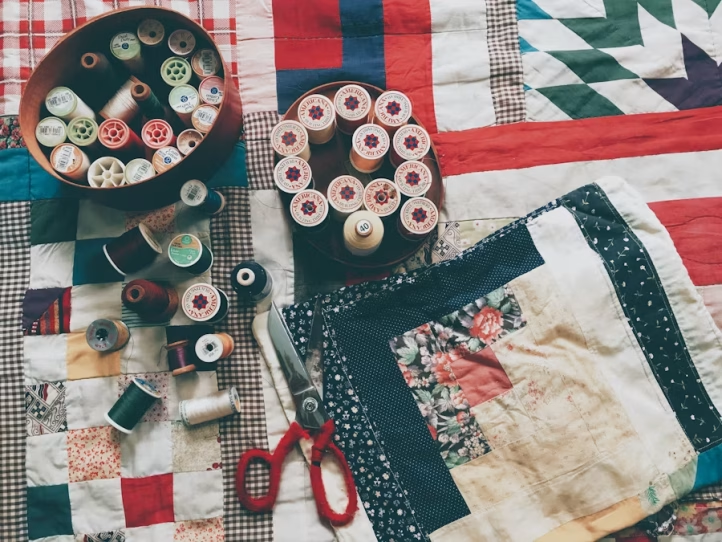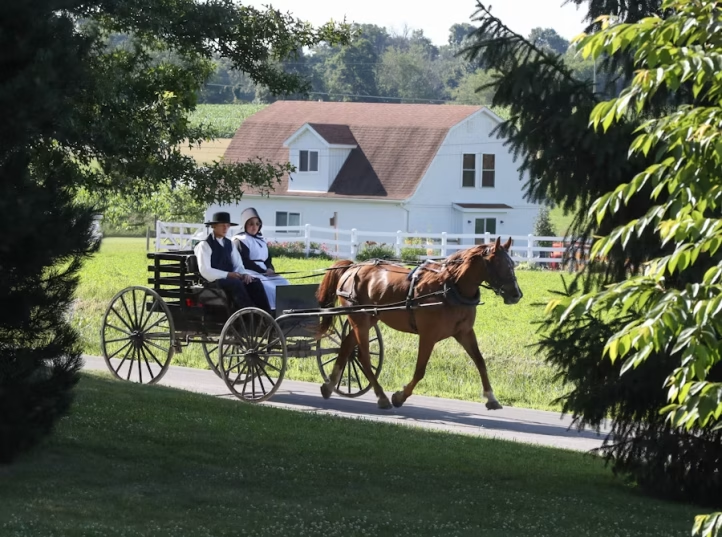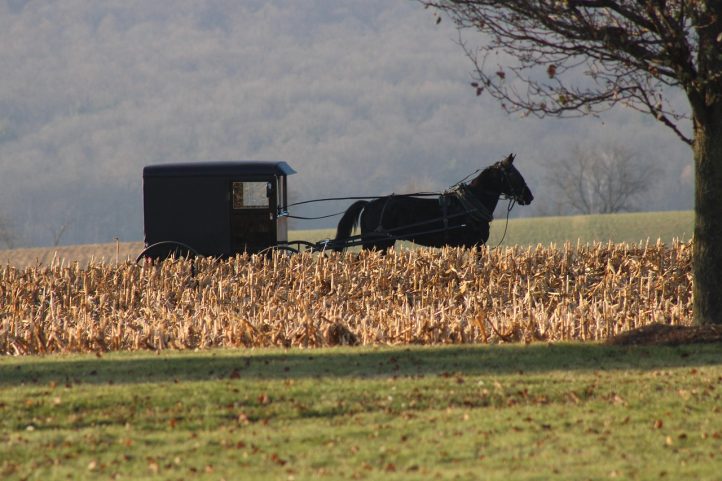
Photo provided by designer.
Through our modern eyes, the Amish community and their traditions look old, (ancient even), and we can be forgiven for expecting that they have been around forever and participating in their homemaking skills, (quilting, for example) forever, too. Whilst the original order have been around for a while in one form or another, the Amish themselves are relatively new to quilting.
History of the Amish

Photo provided by designer.
Like many new communities settling in the New World, the Amish have a religious history. Not a hugely happy or peaceful one either as, like so many others, they struck out on their voyage in an attempt to settle in a place where they could escape religious persecution and gain a small economic advantage in the doing.
The Amish originated in central Europe, mainly Switzerland and Alsace, in 1693, led by a man called Jakob Ammann. His followers were called Amish with a respectful nod to his surname. Actually, it was far from respectful and actually regarded as a term of shame in the old country.
Sadly, one might think that when a group splits away from mainstream society and sets itself up with new ideas and ways of doing things, that they could all agree and just get on with it but that accord and togetherness was not really a feature of Amish history either. The many further splits and arguments caused the believers to distance themselves not only from mainstream communities but also from each other as they moved further away and closed ranks even tighter. The Amish are not one group but several, and sometimes view each other with a certain amount of disapproval as one schism agrees that generators are alright around the home and the next enjoys beer to the horror of another group.
The Amish maintained a distance from the populations around them and largely from each other and although primarily a religious group of the Anabaptist faith, they have also been referred to as an ethnoreligious group since their lifestyle embraces more than simple religious doctrine. It literally is a lifestyle and one like no other: a glimpse into the past, theatrical and looking slightly irrelevant to the fast-paced lifestyle happening around them.
Here again, our modern eyes tell us that there has been very little, if any, change in the Amish population in centuries and here again, we would be absolutely wrong.
Amish Quilting in America

Photo provided by designer.
There have been the complicated splits and schisms over the years and although the Amish are famously slow to adopt any modern conveniences, adopt them they do (some groups quicker than others), and it is the adoption of modern ideas that led the community to the world of quilting in the middle of the nineteenth century. But not in the old country. That particular necessity and pastime arose in America in the latter half of the nineteenth century. I could personally imagine Amish women making quilts from the get-go. Even before that because without this, actually quite erroneous image, I had to ask myself what they used for bedding.
In the early eighteenth century, things seemed to come to a head in Europe and the factions had spread out as far as they felt possible when the option of starting a new life opened up to them. There were offers of land, cheaper and larger tracts than were possible in Central Europe, and the ever popular idea that things would be better all round if the groups could start afresh somewhere else.
But the Amish emigrating from Europe to America in the 1700s brought neither quilts nor know-how with them. In common with the other Germanic people in Europe, they slept on a bag stuffed with straw for a mattress with a feather bed for warmth (and presumably some softer comfort) and some had a woven coverlet on the top. But the one question that I still have is why were they lagging so far behind their non-Amish neighbors, some of whom had been quilting for some time, especially when some of the members of the Amish groups originally came from these non-Amish communities.
After all, before 1693, no one was Amish. Yet they seemed to have lost the skills that they may have had. Mind you, this segues in with the current thinking that it only takes two generations to lose the skills that our communities have. It is still slightly strange that they would have allowed this to happen, especially in a time and place where other alternatives were so scarce. And quilting seems to fit the Amish ideology perfectly, wherever they are living.
Even as late as the 1980s in America, the Amish women lacked the essential hand sewing skills to appliqué and refine their quilts and help was given in this case by the nearby Hmong women.
The Hmong women, who arrived in the United States as refugees from Asia, initially faced challenges due to limited English proficiency and few opportunities to apply their existing skills. However, they demonstrated adaptability and quickly learned new ones. The Mennonite communities sponsored Hmong refugees from the late 1970s, and this led to an exchange of knowledge related to quilting, which benefitted both communities. The Hmong women had needlework skills that the Amish did not and this added knowledge and dexterity with the needle from Asian traditions meant that the Amish quilts had an extra refinement that they lacked before.
Details in Amish Quilting

Photo provided by designer.
It is a feature of almost every civilization to beautify homewares and with this tradition comes some of the most distinctive patterns and the most instantly recognizable symbols. For the Amish, this meant ‘serious’ quilts in darker solid colors with strong geometric patterns.
The making of clothing was given priority, quite naturally, and any quilts had to be made with fabric left over from the essential need to clothe the body modestly. This limited the available quilt fabrics and choices to whatever had been allowed for one need to smoothly dovetail into the next.
But this has had the unexpected benefit that Amish quilts have a surprisingly modern aesthetic and quilts in this style came to the attention of art collectors and dealers in the early 1970s because of their resemblance to modern abstract art. The same colors and patterns which cover a bed in Lancaster County can grace a pared back New York loft at any time of any century. Amish quilts continue to be some of the most coveted and copied. Timeless in any respect but sadly speaking of a timelessness that doesn’t really go back as far as we might think.
As I mentioned, it feels as though the Amish have been quilting for a long time but when you consider that quilting arose in Ancient Egypt and the Amish only really began their journey in the latter half of the 1800s, it really puts it into perspective. Quilting had been viewed by some members of the community with a little bit of suspicion, considering quilts to be modernized goods and although rules gradually relaxed to allow the women to use brighter colors (the ‘oldest’ quilts were limited to the clothing colors of black, brown, rust and blue) and even pastels, the fabric had to be a simple cotton choice- the rest of the world experimented with exotics such as silk, which was decried by the Amish as being a step top far into worldliness.
Another marker of change has been the available patterns for the Amish quilts. Quite naturally, the skill of the maker often decided which patterns could be used but in 1875, around the time that the Amish really entered the quilting race, there were only 380 patterns and this number increased as the Amish allowed progress to enter their lives. The patterns also increased as their skill increased as some are much harder to put together than others.
Once the Amish had accepted the idea that quilting could fit within their ethos of a simple lifestyle, rules were established which ran parallel to their ideologies. Quilts had to be handmade and in the beginning, this meant simple needle and thread. The ‘quilt sandwich’ that we know and practice ourselves was used (backing, batting and top) but piecing, quilting and eventually binding was all hand done. It was an ideal social activity and one which led the community through the darker days of winter when other pastimes were not available.
As the project was worked, the same woman would do the same job on each quilt. Binding, piecing and quilting was all done by the person who normally took that task and no swapping of roles was encouraged. This meant that areas of expertise emerged and the uniformity of stitching and production was preserved.
Soon it was realized that a sewing machine would improve production somewhat more whilst still fitting with the simple lifestyle of the Amish- provided that it was non-electric. This meant that the quilt was still nominally handmade but it was stronger and more durable. For the Amish, quilts were now an integral part of their life and were given as important gifts such as childbirth and marriage, and they were made to be handed down.
Although the rather surprising theme of this article has been that the Amish began their quilting journey relatively late, they have been some of the most consistent quilters, carrying on through the Great Depression when fabric was scarce and again through World War II when availability was challenged once again.
Nowadays, Amish girls are taught to quilt from a very young age and by the time they reach their teens, they are capable of an impressive range of skills. The Amish community have at last achieved the skills and traditions that most of us have assumed that they had for centuries.
